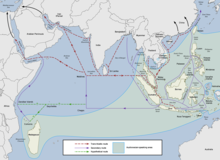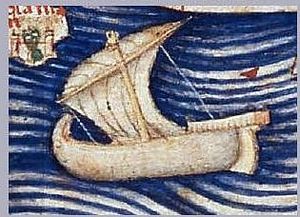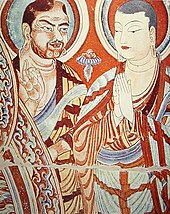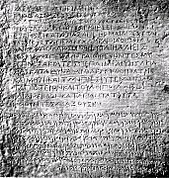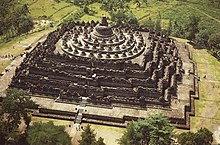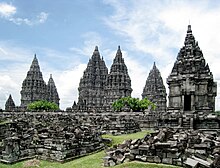History of Indian influence on Southeast Asia
The peoples of maritime Southeast Asia — present-day Malaysia, Indonesia and the Philippines — are thought to have migrated southward from South China sometime between 2500 and 1500 BC.
Austronesian sailors from Island Southeast Asia first established contact and trade with Southern India and Sri Lanka as early as 500 BCE.
[11] Next, with Moggaliputta-Tissa's help, Ashoka sent Buddhist missionaries to distant regions such as Kashmir, Gandhara, Himalayas, the land of the Yonas (Greeks), Maharashtra, Suvannabhumi, and Sri Lanka.
[19] In Java and Borneo, the introduction of Indian culture created a demand for aromatics, and trading posts here later served Chinese and Arab markets.
[38][39][40] The Tang dynasty (618–907) of China, the Srivijaya empire in Maritime Southeast Asia under the Sailendras, and the Abbasid caliphate at Baghdad were the main trading partners.
[42] Indian spice exports find mention in the works of Ibn Khurdadhbeh (850), al-Ghafiqi (1150 CE), Ishak bin Imaran (907) and Al Kalkashandi (14th century).
Richard Foltz, Xinru Liu, and others have described how trading activities along the Silk Road over many centuries facilitated the transmission not just of goods but also ideas and culture, notably in the area of religions.
Zoroastrianism, Judaism, Buddhism, Christianity, Manichaeism, and Islam all spread across Eurasia through trade networks that were tied to specific religious communities and their institutions.
[49][50] The transmission of Buddhism to China via the Silk Road began in the 1st century CE, according to a semi-legendary account of an ambassador sent to the West by the Chinese Emperor Ming (58–75).
[59] Extensive contacts started in the 2nd century, probably as a consequence of the expansion of the Kushan empire into the territory of the Tarim Basin, due to the missionary efforts of a great number of Buddhist monks to Chinese lands.
[61] Knowledge among people on the silk roads also increased when Emperor Ashoka of the Maurya dynasty (268–239 BCE) converted to Buddhism and raised the religion to official status in his northern Indian empire.
[71] The first of these Hinduised states to achieve widespread importance was the Kingdom of Funan founded in the 1st century CE in what is now Cambodia — according to legend, after the marriage of a merchant Buddhist monk Kaundinya I with princess Soma who was the daughter of the chieftain of the local Nāga clan.
It reached the peak of its fame under Jayavarman VII at the end of the 12th century, when its conquests extended into Thailand in the west (where it had conquered the Mon kingdom of Dwaravati) and into Champa in the east.
Outside products brought to the region included metal goods, rice, fine textiles, and coins exchanged for local spices, sandalwood, deer horn, bees' wax, and slaves.
[72] Oral traditions of people of Wehali principality of East Timor mention their migration from Sina Mutin Malaka or "Chinese White Malacca" (part of Indianised Hindu-Buddhist Srivijaya empire) in ancient times.
In the islands of Southeast Asia, one of the first organised state to achieve fame was the Buddhist Malay kingdom of Srivijaya, with its capital at Palembang in southern Sumatra.
In the 8th century CE, Sri Gotapura (Sikhottabong) was the strongest of these early city states, and controlled trade throughout the middle Mekong region.
The ancient Indian text Vayu Purana also mentioned a place named Malayadvipa where gold mines may be found, and this term has been proposed to mean possibly Sumatra and the Malay Peninsula.
According to the Sejarah Melayu ("Malay Annals"), the Khmer prince Raja Ganji Sarjuna founded the kingdom of Gangga Negara (modern-day Beruas, Perak) in the 700s.
A fourth phase of foreign influence was immigration of Chinese and Indian workers to meet the needs of the colonial economy created by the British in the Malay Peninsula and Borneo.
[104] The Greco-Roman astronomer Ptolemy (90–168) identified a place called Sabana at the tip of Golden Chersonese (believed to be the Malay Peninsula) in the second and third century.
[109] The earliest written record of Singapore may be in a Chinese account from the third century, describing the island of Pu Luo Chung (蒲 羅 中).
[116] In 1320, the Mongol Empire sent a trade mission to a place called Long Ya Men (or Dragon's Teeth Gate), which is believed to be Keppel Harbour at the southern part of the island.
The Sejarah Melayu (Malay Annals) contains a tale of a prince of Srivijaya, Sri Tri Buana (also known as Sang Nila Utama), who landed on Temasek after surviving a storm in the 13th century.
[124] Historians believe that during the late 14th century, Parameswara, the last Srivijayan prince, fled to Temasek from Palembang after being deposed by the Majapahit Empire.
This is a show in which shadows of pieces of cow or water buffalo hide cut to represent human figures with movable arms and legs are thrown on a screen for the entertainment of spectators.
An indication of the close linguistic affiliation between India and Thailand is found in common Thai words like Ratha Mantri, Vidhya, Samuthra, Karuna, Gulab, Prannee etc.
Though the ceremony was abolished during the reign of King Rama VII due to a severe economic fall, Brahman priests are still allocated money to make offerings to God Shiva.
Thai people still seek advice from knowledgeable Buddhist monks or Brahman astrologers about the auspicious or inauspicious days for conducting or abstaining from ceremonies for moving house or getting married.
Unlike other Southeast Asian countries (except for Singapore and the Philippines), Vietnam was influenced by the Indian-origin religion Buddhism via the strong impact of culture of China.

